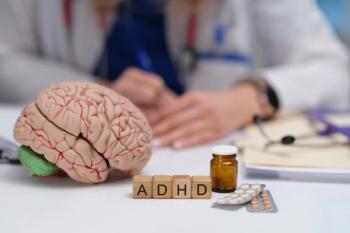
- Consultant for Pediatricians Vol 5 No 8
- Volume 5
- Issue 8
ADHD: A Guide to Assessment and Diagnosis
Attention deficit hyperactivity disorder (ADHD) is the most commonly diagnosed bio-behavioral disorder of childhood. It occurs in 6% to 9% of children--about the same prevalence as childhood asthma. It is also one of the most controversial diagnoses in children; parents are often perplexed about whether ADHD is underdiagnosed or overdiagnosed, or undertreated or overtreated. A good deal of this confusion stems from the fact that there are no laboratory tests, imaging studies, or psychological testing profiles that can be used to make the diagnosis.
Attention deficit hyperactivity disorder (ADHD) is the most commonly diagnosed bio-behavioral disorder of childhood. It occurs in 6% to 9% of children--about the same prevalence as childhood asthma. It is also one of the most controversial diagnoses in children; parents are often perplexed about whether ADHD is underdiagnosed or overdiagnosed, or undertreated or overtreated. A good deal of this confusion stems from the fact that there are no laboratory tests, imaging studies, or psychological testing profiles that can be used to make the diagnosis.
Theories abound about the cause of ADHD. These include the impact of genetic factors, variations in temperament and emotional reactivity, neurologic factors, and a host of environmental influences on the developing brain. ADHD is a heterogeneous condition, and many diverse biologic and environmental factors--alone or in combination--can result in the behaviors that lead to the diagnosis of ADHD.
The core symptoms of ADHD are inattention, hyperactivity, and impulsivity; the case vignette in the Box illustrates typical ways in which these manifest. The disorder can be thought of as a spectrum of "attention disorders" rather than a single entity.
Because of the high prevalence of ADHD, and because pediatricians have many opportunities to screen for ADHD before parents might be alerted to seek care, evaluation and management of ADHD are important and doable tasks for primary care pediatricians.
The American Academy of Pediatricians' Guidelines for Evaluation and Diagnosis of ADHD describe a format for evaluating a child with ADHD from an evidence-based or best practice perspective.1 This article is organized around those recommendations.
GUIDELINES FOR DIAGNOSING ADHDRecommendation 1: In a child aged 6 to 12 years who presents with inattention, hyperactivity, impulsivity, academic underachievement, or behavior problems, primary care clinicians should initiate an evaluation for ADHD.
Questions about ADHD can come from parents or teachers. When attention problems or hyperactivity or impulsivity are the concerns, an evaluation is indicated. If you want to screen or conduct some surveillance, you might consider using a questionnaire that can be given to parents of school-aged children at well-child or other non-acute visits. The kinds of questions that could be asked include:
- How is your child doing in school?
- Are there any learning problems?
- Is your child happy in school?
- Are there any behavior problems in school, at home, or with friends?
- Is your child having problems completing classwork or homework?
During adolescent health supervision visits, questions can be modified. Ask about difficulties with organization, forgetfulness, careless work, procrastination, and/or difficulty in completing or turning in homework. Inquire, too, about high-risk behaviors, including truancy, substance abuse, oppositional behavior, fighting, and sexual activity. Any positive responses provide reasonable grounds for considering an evaluation for ADHD.
Recommendation 2: The diagnosis of ADHD requires that a child meet DSM-IV criteria.
Just as laboratory tests, imaging studies, and psychological tests cannot be used to make a definitive diagnosis of ADHD, there are no set observations or physical findings that can be reliably used during the office visit. The current gold standard for making the diagnosis, however imperfect, requires that children meet the criteria for ADHD as spelled out in the current version of the Diagnostic and Statistical Manual, Fourth Edition, of the American Psychiatric Association--the DSM-IV.2 Those criteria are reviewed in Table 1.
The DSM-IV requires that children meet these diagnostic criteria across the major settings of their life (home and school). There needs to have been some indication that these problems were present before the child's seventh birthday, and the symptoms need to be causing significant functional problems (functional disabilities).
- Six or more inattentive symptoms are compatible with predominantly inattentive ADHD.
- Six or more hyperactive/impulsive symptoms are compatible with predominantly hyperactive/impulsive ADHD.
- Six or more of both are compatible with combined type ADHD.
Recommendation 3: The assessment of ADHD requires evidence directly obtained from parents or caregivers regarding the core symptoms of ADHD in various settings, age at onset, duration of symptoms, and degree of functional impairment.
Recommendation 4: The assessment of ADHD requires evidence directly obtained from the classroom teacher (or other school professional) regarding the core symptoms of ADHD, the duration of symptoms, the degree of functional impairment, and coexisting conditions.
A careful history confirmed and elaborated the information summarized in the case vignette about Kevin (see Box). His pediatrician reviewed the teacher's ratings on the Vanderbilt Scale. That scale contains the full diagnostic criteria for ADHD (items 1 to 18) and some of the criteria for related disorders.
The Vanderbilt Scales are among the many checklists used by parents and teachers to screen for ADHD. The Vanderbilt Scaleshave the advantage of containing DSM-IV criteria instead of other behavioral descriptions; they also include screens (not complete criteria) for conditions that commonly coexist with ADHD. These include oppositional defiant disorder (ODD), conduct disorder, anxiety disorders, and depression. Information on scoring is given in Table 2.
The scoring stipulates that even if the criteria for ADHD are met, the diagnosis should not be made unless the child also has significant difficulty in functioning (items 36 to 43). Kevin clearly meets the criteria for combined type ADHD at school by his teacher's endorsements on the Vanderbilt Scales. The diagnostic criteria need to be met at home as well; this was established when a parent Vanderbilt Scale filled out by his mother during the office visit also showed that Kevin meets the criteria for combined type ADHD.
With Kevin, the onset of symptoms occurred in kindergarten (before age 7, as the DSM-IV criteria demand). After the history, and a review of the Vanderbilt Scale ratings, his pediatrician felt comfortable making the diagnosis of ADHD combined type.
If a child does not meet criteria at home and school, an ADHD diagnosis should not be made without further exploring the factors leading to the discrepancy. For example, a child who tunes out in school because of a significant learning disability in reading could appear to have predominantly inattentive ADHD. Similarly, a child living at home with significant parental discord, illness, or mental health issues could also be distractible and overactive in school without having ADHD.
FUNCTIONAL IMPAIRMENT
Recommendations 3 and 4 require the pediatrician to look for areas in which ADHD symptoms significantly affect a child's functioning (areas of functional impairment)--in addition to determining whether he or she meets diagnostic criteria for ADHD. If a child meets criteria for ADHD but is functioning well at home and school, there is no reason to make this diagnosis. The inattentive, hyperactive, and impulsive symptoms of ADHD can lead to marked impairment in key areas of functioning essential for optimal development. These then become the targets for treatment rather than the ADHD symptoms themselves.
Delineating areas of functional impairment is essential to an understanding of the impact on an individual child or adolescent. Known areas of functional impairments associated with ADHD include family relationships (particularly through oppositional and defiant behavior and conduct problems), peer status, and social skills, academic achievement, self-esteem, and self-perception--as well as an increase in accidental injuries. Disabilities in these areas can be pervasive, severe, and debilitating: they need to be defined in detail. The Vanderbilt Scales can give clues about these areas of functional impairment in items 36 to 43.
By his teacher's report, Kevin has functional disabilities in reading and written expression. He demonstrates an inability to follow directions and to complete assignments.
From an interview with Kevin's mother and a review of her Vanderbilt Scale rating, it is clear that oppositional and defiant behavior is also of significant concern at home.
IS IT REALLY ADHD?
Before deciding that ADHD is the correct diagnosis, consider whether the ADHD symptoms may be caused by other conditions. In the psychosocial area, symptoms mimicking ADHD may stem from physical or sexual abuse or a response to inappropriate parenting practices, parental psychopathology, or an inappropriate classroom setting.
Medical disorders that cause ADHD symptoms include neurologic and thyroid conditions, heavy metal poisoning, iron deficiency, side effects of medications, substance abuse, or undiagnosed hearing or vision impairments. Although certain mental health and learning disorders can coexist with ADHD (see below), they can also present with ADHD behaviors. These include ODD, conduct disorder, anxiety disorders, depressive disorders, learning disorders, and language disorders.
ADHD behaviors can also be part of other conditions, such as fragile X syndrome, fetal alcohol spectrum disorders, autism spectrum disorders, obsessive-compulsive disorder, Tourette syndrome, attachment disorders, and psychosis. Consider these differential diagnoses before you make the diagnosis of ADHD.
Recommendation 5: Evaluation of the child with ADHD should include assessment for coexisting conditions.
It is common for children with ADHD to have one or more associated diagnoses. Different coexisting conditions are associated with different subtypes of ADHD. Table 3 lists the major coexisting conditions, their prevalence in children with ADHD, and their subtype associations.
A review of Kevin's teacher's Vanderbilt Scale rating shows him to be at risk for depressive disorders and for a learning disorder in reading and written expression. The history from his mother and review of her Vanderbilt Scale ratings shows probable ODD at home. Full criteria for ODD, conduct disorder, anxiety and depressive disorders, learning and language disorders can be found in the DSM-IV and the DSM for primary care of children (DSM-PC).2,3
Whether to diagnose some of these coexisting conditions or to consider them part of the functional disability from ADHD can sometimes be a tricky business. Kevin's ODD behaviors are likely to become much less of a problem after treatment with stimulant medication--if they are largely a function of his impulsivity rather than learned behaviors that are being inadvertently reinforced by his parent's responses. His depressive symptoms at school may be a result of his being demoralized by his poor functioning because of his ADHD symptoms; they may not be a separate depressive disorder. Kevin's possible learning disorder in reading and written expression may get much better after a period of optimal medication management--if the disability is caused by problems in paying attention to the material rather than by a true learning disability (a significant gap between abilities [IQ] and achievement as measured by a standardized achievement test individually administered by his school psychologist).
Because of considerations like these, assessment should be seen as an ongoing process rather than a one-time diagnostic snapshot. Continuity of care is essential here, as it is in any chronic illness or condition.
Recommendation 6: Other diagnostic tests are not routinely indicated to establish the diagnosis of ADHD.
Studies do not support the routine use of other diagnostic tests to establish the diagnosis of ADHD. Computerized tests of attention, brain imaging studies, and EEG patterns do not clearly distinguish children with ADHD from children with related disorders or their nonclinical peers. Laboratory tests, including hematocrit measurements, thyroid function tests, lead levels, and chemistry panels, are also not indicated.
THE PEDIATRICIAN'S ROLE, AND WHEN TO REFER
The high prevalence of ADHD makes it critical for primary care pediatricians to learn to feel comfortable diagnosing and treating the majority of children and adolescents with ADHD. This takes a bit of a paradigm shift from diagnosing other common medical problems in which clinical findings in the office and laboratory tests make diagnosis possible in a 15- to 30-minute office visit. On the other hand, tools like the Vanderbilt Scales or similar behavioral rating scales can make diagnosis very doable. Several strategies can be helpful. Some of these strategies are summarized in Table 4.
Primary care pediatricians should be able to become comfortable diagnosing and treating the majority of children with ADHD. Consider referring to a developmental behavioral pediatrician, psychologist, psychiatrist, or other appropriate specialist when there is considerable family dysfunction, unmanageable serious behavioral problems, a high suspicion of serious depression, or anxiety or language disorder.
Children who do not quite meet criteria for ADHD but who are having a great deal of functional disability often present a diagnostic dilemma. Take care before applying the ADHD label. These children are also good candidates for referral to a specialist.
Articles in this issue
over 19 years ago
Photoclinic: Tinea Capitisover 19 years ago
Photoclinic: Pathologic Fracture of an Aneurysmal Bone Cystover 19 years ago
Pediatric Chest Pain: Keys to the Diagnosisover 19 years ago
Juvenile Plantar Dermatosis and Seborrheic Dermatitisover 19 years ago
Case in Point: Infant With an "Atypical Mole"over 19 years ago
Treatment of ADHD: A Developmental Approachover 19 years ago
Photoclinic: Schizencephalyover 19 years ago
ADHD: Answers to Questions Physicians Often AskNewsletter
Access practical, evidence-based guidance to support better care for our youngest patients. Join our email list for the latest clinical updates.









